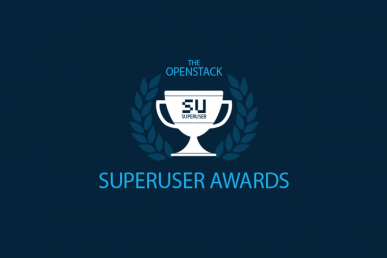It’s time for the community to determine the winner of the Superuser Award to be presented at the OpenStack Austin Summit. Based on the nominations received, the Superuser Editorial Advisory Board conducted the first round of judging and narrowed the pool to four finalists.
Now, it’s your turn.
The team from DreamHost is one of the four finalists. Review the nomination criteria below, check out the other nominees and cast your vote before the deadline, Friday, April 8 at 11:59 p.m. Pacific Daylight Time. Voting is limited to one ballot per person.
How has OpenStack transformed your business?
OpenStack has enabled DreamHost to launch a new business unit focused on cloud services, including DreamCompute, our public cloud compute service based upon OpenStack, Ceph, and Project Astara. OpenStack boosted DreamHost’s hosting business with a new revenue stream from an entirely new customer base – developers and open source entrepreneurs, including DreamHost’s largest paying customer in its 17-year history, who is transitioning its infrastructure off of a legacy provider to DreamHost’s emerging OpenStack cloud. Established in 1997 in Southern California, DreamHost has surfed every technological wave to enable developers and entrepreneurs to achieve their dreams online. In 2012, the DreamHost team started adding cloud-specific products to its hosting products. The launch of DreamCompute beta was a huge success:
- Customer demand enabled DreamHost to fill its beta DreamCompute cluster with paying beta testers in a matter of months.
- Thousands of VMs have been launched and destroyed.
- DreamCompute also incubated and contributed Project Astara to the OpenStack Big Tent. Project Astara enables OpenStack clouds to deploy and orchestrate virtualized network functions like routing, load balancing, VPN, and firewall.
- Exciting and inspiring customer success stories have emerged, including Killowatts for Humanity, a nonprofit organization that has been introducing electricity to rural communities globally for the past six years in an effort to end energy poverty featured in Superuser Magazine.
DreamCompute is based on OpenStack and is integrated with two innovative technologies developed and released by DreamHost: Ceph and Astara. DreamCompute’s physical network is based on Cumulus Networks’ white box switching operating system, Cumulus Linux. With a pedigree like that, DreamCompute can rightfully claim to be the number one open source public cloud for developers and entrepreneurs. DreamHost is launching DreamCompute 2.0 with massive performance gains, providing access to a top-notch OpenStack deployment to developers around the world.
How has the organization participated in or contributed to the OpenStack community?
DreamHost believed in OpenStack from the get-go, adopting OpenStack’s code and joining the Foundation as a founding Gold member, and has been attending OpenStack Summits since Diablo. DreamHost employees have been project team leads (PTLs) of several key OpenStack projects, including Neutron, Cinder and Oslo. Contributions of the DreamHost Cloud team continue today in other areas, from the OpenStack Operators (OSops) projects to Documentation, and in key working groups, including Product and App Developers. DreamHost developers also contribute upstream to many OpenStack projects. DreamHost also has contributed its architecture designs, providing inspiration inside the community to integrate OpenStack with Ceph. More recently in the networking space, Astara has been accepted to the OpenStack big tent after being incubated at DreamHost. DreamCompute’s two regions run the full open source upstream code for all its components, no secret sauce added. DreamHost employees are also the original authors and current maintainers of Pecan, the Python web framework powering many OpenStack APIs.
What is the scale of your OpenStack deployment?
DreamCompute was first released as an alpha in 2013, powering one of the few OpenStack public clouds in the world. The first cluster of DreamCompute started in one region, with an architecture based on Nicira NVP, Open vSwitch, project Astara, and Ceph. Within months of its public beta release in 2015, DreamCompute’s beta filled to capacity, serving thousands of VMs and customers, including production workloads. In March 2016, the next generation general availability region of DreamCompute hit the scene with an entirely new architecture, fully built on SSD-backed Ceph block storage and powerful virtual networking powered by Project Astara, VxLAN and Cumulus Linux. The new region is built to scale with customer demand, starting with enough capacity to power DreamHost’s largest ever customer, with a utilization of over 1 TB of RAM, over 700 virtual cores, and nearly 50 TB of block and object storage supporting tens of thousands of customers. The fully provisioned first pod of DreamCompute’s new region provides capacity for over 17 TB of RAM, with an aim to serve tens of thousands of customers.
How is the team innovating with OpenStack?
The DreamHost team created Ceph and Project Astara to bring the open source cloud to developers and entrepreneurs. In addition, DreamHost employees have driven the creation of several new OpenStack projects and initiatives, including Ceilometer and Oslo. The story of DreamHost’s cloud demonstrates how OpenStack can be a powerful innovation engine. DreamHost created and incubated the Ceph storage project, and eventually spun out Inktank to support its development, eventually selling Inktank to Red Hat in one of the largest OpenStack-related business successes in OpenStack’s short history. Ceph’s source code was first published in 2004 and in September 2012, DreamHost launched its first cloud service, DreamObjects, an object storage service compatible with both the OpenStack Swift API and the Amazon S3 API. The team worked with the OpenStack community to integrate Ceph, enabling DreamHost to announce DreamCompute in October 2012. Ceph soon became wildly popular in powering block storage for OpenStack clouds, being adopted by cloud giants like CERN. In designing DreamCompute to provide sophisticated software-defined networking, DreamHost became an early customer of Nicira for its NVP network virtualization platform, helping drive and influence the creation and early development of Neutron. Shortly thereafter, the DreamHost cloud team created Project Astara, which still powers DreamCompute’s advanced networking features today. In addition, one of DreamHost’s developers became the PTL of the Neutron project.
DreamHost is also looking at integrating more OpenStack components from the ecosystem to better serve public cloud customers and the internal needs of the company. In the evaluation pipeline are Magnum, Trove, Murano, Monasca, Heat and Ceilometer.
Who are the team members?
- Jonathan LaCour, vice president of cloud
- Justin Lund, Dir. Cloud Product Manager
- Kris Bernard, director of project management
- Jordan Tardif, director of cloud engineering
- Jeremy Hanmer, senior principal architect
- Rosario Di Somma, cloud developer
- David Wahlstrom, cloud systems engineer
- Chris Lee, cloud quality assurance
- Justin Knierim, cloud support coordinator
- Ryan Petrello, senior cloud developer
- Stefano Maffulli, director of cloud marketing
- Caleb Boylan, cloud intern
Find out more about the Austin Superuser Awards finalists here and cast your vote. Friday, April 8 at 11:59 p.m. Pacific Daylight Time. Voting is limited to one ballot per person.
Cover image courtesy DreamHost.
- Exploring the Open Infrastructure Blueprint: Huawei Dual Engine - September 25, 2024
- Open Infrastructure Blueprint: Atmosphere Deep Dive - September 18, 2024
- Datacomm’s Success Story: Launching A New Data Center Seamlessly With FishOS - September 12, 2024

)










